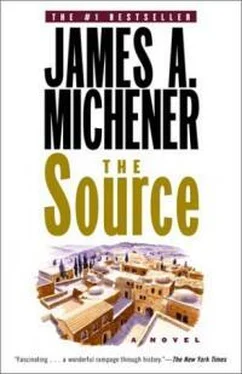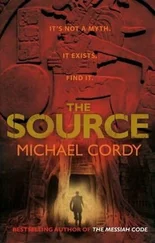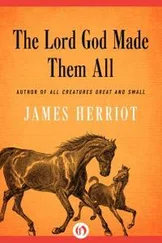Джеймс Миченер - The Source
Здесь есть возможность читать онлайн «Джеймс Миченер - The Source» весь текст электронной книги совершенно бесплатно (целиком полную версию без сокращений). В некоторых случаях можно слушать аудио, скачать через торрент в формате fb2 и присутствует краткое содержание. Год выпуска: 1983, ISBN: 1983, Издательство: Random House, Inc., Жанр: История, на английском языке. Описание произведения, (предисловие) а так же отзывы посетителей доступны на портале библиотеки ЛибКат.
- Название:The Source
- Автор:
- Издательство:Random House, Inc.
- Жанр:
- Год:1983
- ISBN:9780449211472
- Рейтинг книги:5 / 5. Голосов: 1
-
Избранное:Добавить в избранное
- Отзывы:
-
Ваша оценка:
- 100
- 1
- 2
- 3
- 4
- 5
The Source: краткое содержание, описание и аннотация
Предлагаем к чтению аннотацию, описание, краткое содержание или предисловие (зависит от того, что написал сам автор книги «The Source»). Если вы не нашли необходимую информацию о книге — напишите в комментариях, мы постараемся отыскать её.
The Source — читать онлайн бесплатно полную книгу (весь текст) целиком
Ниже представлен текст книги, разбитый по страницам. Система сохранения места последней прочитанной страницы, позволяет с удобством читать онлайн бесплатно книгу «The Source», без необходимости каждый раз заново искать на чём Вы остановились. Поставьте закладку, и сможете в любой момент перейти на страницу, на которой закончили чтение.
Интервал:
Закладка:
It was the second gate, a postern in the north wall, that accounted for the most noticeable change. In several sieges of Makor the enemy had triumphed by capturing the well outside the wall and mounting siege until the internal cisterns were empty. Then, faced by thirst, the town had been forced to surrender, so in 1440 B.C.E. the town fathers, led by a strong-minded young man named Uriel, had decided to build a pair of stout walls leading out from the postern gate and surrounding the vital well. The walls were built and then roofed over, which had the effect of bringing the source of water inside the town, so that in time of siege the women of Makor could walk in darkness and safety from town to well and thus keep the cisterns full. As a result of this extension to the north, Makor now looked like a symbolic representation of the male reproductive organs; and perhaps for this reason the waterwall had proved its effectiveness during several would-be sieges from which the attackers had withdrawn after discovering that they could not capture the water supply.
The great Family of Ur was now represented by this builder Uriel, who had persuaded his elders to construct the waterwall. Incontestably he was the leading citizen of Makor, the man who owned the olive groves south of town and the oak forests to the east. He was forty-one years old, taller than the average Canaanite and more thoughtful. The priests of Baal looked to him for guidance; at first they had opposed the building of the waterwall, arguing that if Baal had intended his well to be protected he would have cared for the matter himself, but when Uriel’s strategy proved right they changed their criticism to support. There was now no king of Makor, the Hyksos invaders having exterminated the royal family, but Uriel served so many of the ancient functions that he enjoyed a quasi-kingship. In the official records kept in Egypt, which now ruled the area, he was known as governor, a role which he filled rather better than most of the Egyptian appointees in neighboring towns like Hazor, Megiddo and Akka.
Uriel wore a black beard, trimmed square below his chin, and he was unusual in that age in that he had but one wife, Rahab, by whom he had one child, his son Zibeon. Concubines were not important in his life; he had several, as befitted a man of his dignity, but their children he did not bother about and as he grew older he no longer found it necessary to surround himself with younger women. He loved his one wife and found her both a congenial companion and a wise counselor.
He was a man devoted to Makor. When younger he had served as general of the army in days when a force of four hundred well-armed men could be put into the field. Twice the Egyptians had chosen him to serve as their field commander of contingents requisitioned in the area, and he had roamed as far afield as Carchemish and Damascus, but always he returned happily to Makor. It was he who initiated the practice of having the governor live adjacent to the main gate so that any merchant entering or leaving town might find him easily to consult on matters involving taxation. His home was a large fortified building wedged into the western wall of the gate, with two entrances, one for his family leading into the town and the other an official door that led from his office directly into the zigzag passage. He was so concerned with the administration of Makor that he often perched himself on a three-legged stool inside the gate, chatting with anyone who passed and gossiping about the government of the town. Under Uriel’s leadership Makor had prospered. Outside the walls many farmers produced food surpluses that were sent by caravan to Akka, while inside the town other men operated a sophisticated economic system based upon the manufacture of pottery from clay found in the wadi, the weaving and dyeing of cloth, and the casting of bronze implements of a high quality: the copper required was brought north by donkey caravan from mines south of the Red Sea; the tin came to Akka by ship from ports in Asia Minor and the finished ware went out to many towns and cities. In Makor no one used flints.
The primary producers of pottery, cloth and bronze were supported by middlemen who provided funds for bringing raw materials in and who undertook the risk of shipping the goods out. They also supplied local shops, which sold not only things manufactured in the town but also objects imported from specialized centers as far away as Cyprus, Greece and Crete to the west, and Damascus and India to the east. The people of Makor ate well, dressed well, prayed to an organized trinity of gods who protected them efficiently, and enjoyed as secure a form of government as any known in the region between Mesopotamia and Egypt.
If on the one hand they had not yet discovered the concept of coinage, they did have a well-tested system of money-by-weight, whereby gold and silver could be sent long distances to pay bills; and if they did not have an organized system of posts they had messengers who moved regularly back and forth between the rivers. Uriel could write in three languages: the Akkadian cuneiform of Mesopotamia, which was the principal language for all diplomatic or business transactions; the hieroglyphs of Egypt for governmental reports; and the new form of writing used in northern Canaan, from which the alphabet would ultimately develop. On his desk he kept a set of scarabs carved in Egypt which he used to sign his clay tablets or to stamp the handles of jugs used to measure wine and grain. He had no books, but he did have collections of clay tablets on which important ideas were codified, and he knew by memory many rhymed legends from Mesopotamia and Canaan, especially the local epic dealing with Baal and Astarte in the nether world. He did not realize that this poem was a recapitulation of adventures in which his ancestors had been involved, and if someone had informed him of that fact he would have been embarrassed, for he was a man devoid of vanity or any desire to compete with the gods.
At forty-one Uriel was a judicious administrator who found personal pleasure when his fields produced more wheat or his olives a better press of oil. The only point on which he could be considered vain was his son Zibeon, twenty-one years old, dark-haired and handsome. For a while it had looked as if the young man might get into trouble by trying to force his attentions upon girls whose parents did not wish their daughters to marry at fourteen, even though peasant families permitted this; but as a result of pressure from Uriel, his son had taken a Hyksos mistress and that crisis had passed. In the meantime, the governor had been reviewing the families of his friends and it seemed probable that soon his son would marry.
On the spring day in 1419 B.C.E. when Zadok and his Hebrews were approaching Makor from the east, Governor Uriel perched on his three-legged stool, so situated that he could inspect anyone coming up the ramp and at the same time look into town to see what was occurring there. In the latter direction he could view a complex society consisting of Hyksos soldiers who had left the battlefield, Egyptian settlers, a few Africans, a handful of Hebrews who had straggled down from the north, and half a dozen other kinds of people from the sea and the desert. Even those who were properly called Canaanites were of a grandly confused background, but all lived together in a kind of tolerant amalgam. A short, swarthy young man with a sharply hooked nose detached himself from the crowd and walked toward Uriel.
“Would the governor care to inspect?” the young Hittite asked. His parents had reached Makor during a raid by mercenaries from the north.
“Are things prepared?” Uriel asked. The young man nodded, whereupon the governor directed a guard to take the stool back into the office while he joined the Hittite and walked along the broad main street that cut directly across the mound from the main gate to the postern. As he went he inspected the shops that lined the thoroughfare: the pottery shop that sold beautiful ware from the Greek islands; the cloth shop that had more than two dozen kinds of fabric; and the metal shop that had swords and daggers and jewelry highly burnished. As always, he checked the grain silos and the water cisterns to see that they were in good order, then proceeded to the area east of the postern gate where the potters threw clay upon their wheels and shaped the vessels that would be sold next month. Here kilns burned slowly, baking the better clay until it rang like glass, while at the bronze forge teams of young apprentices blew through long pipes bringing small furnaces to a blaze, or worked bellows to achieve the same effect in the larger furnaces.
Читать дальшеИнтервал:
Закладка:
Похожие книги на «The Source»
Представляем Вашему вниманию похожие книги на «The Source» списком для выбора. Мы отобрали схожую по названию и смыслу литературу в надежде предоставить читателям больше вариантов отыскать новые, интересные, ещё непрочитанные произведения.
Обсуждение, отзывы о книге «The Source» и просто собственные мнения читателей. Оставьте ваши комментарии, напишите, что Вы думаете о произведении, его смысле или главных героях. Укажите что конкретно понравилось, а что нет, и почему Вы так считаете.








![Джеймс Купер - Пионеры, или У истоков Саскуиханны [The Pioneers, or The sources of the Susquehannah]](/books/395797/dzhejms-kuper-pionery-ili-u-istokov-saskuihanny-t-thumb.webp)

